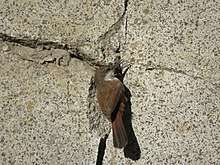Crag chilia
The crag chilia (Ochetorhynchus melanurus) is a species of bird in the family Furnariidae (ovenbirds). It is endemic to Chile.[2][3]
| Crag chilia | |
|---|---|
 | |
| Scientific classification | |
| Kingdom: | Animalia |
| Phylum: | Chordata |
| Class: | Aves |
| Order: | Passeriformes |
| Family: | Furnariidae |
| Genus: | Ochetorhynchus |
| Species: | O. melanurus |
| Binomial name | |
| Ochetorhynchus melanurus (Gray, 1846) | |
| Synonyms | |
| |
Taxonomy and systematics
The crag chilia was formerly placed in its own genus, Chilia. It is now placed in genus Ochetorhynchus with the straight-billed earthcreeper (O. ruficaudus) and band-tailed earthcreeper (O. phoenicurus). Two subspecies are recognized, O. m. melanurus and O. m. atacamae.[2][4]
Description
The crag chilia weighs from 31 to 40 g (1.1 to 1.4 oz) and is 18 to 19 cm (7.1 to 7.5 in) in length. O. m. melanurus is dark brown above with a rufous rump and flanks, grayish breast, and brown belly. O. m. atacamae is similarly colored but paler overall.[4]
Distribution and habitat
The crag chilia is endemic to central and north-central Chile between approximately 27° and 35° south latitudes. It is found primarily at elevations from 1,400 to 3,000 m (4,600 to 9,800 ft) but also at lower elevations in winter. Subspecies O. m. melanurus is found in the southern part of its range and O. m. atacamae is in the north.[5][4]
It is found on shrubby rock hillsides and cliffs with sparse vegetation.[6][4]
Behavior and ecology
The crag chilia's diet is predominately arthropods but also includes seeds. It is usually a solitary forager that gleans from rocks and probes crevices.[4]
The species is presumed to be monogamous and its nesting season to be the austral spring and summer. The nest is a bulky ball of sticks lined with feathers and is usually placed in a rock cavity, though some have been found in holes in earth banks and rural buildings.[4]
Status
The crag chilia is considered of least concern by the IUCN.[1] Though it has a restricted range, its habitat is rather remote and therefore not heavily disturbed by humans.[4]
References
- BirdLife International 2016. Ochetorhynchus melanurus. The IUCN Red List of Threatened Species 2016: e.T22702120A93861147. https://dx.doi.org/10.2305/IUCN.UK.2016-3.RLTS.T22702120A93861147.en. Downloaded on 31 March 2020. "Ochetorhynchus melanurus". IUCN Red List of Threatened Species.CS1 maint: ref=harv (link)
- Gill, F.; Donsker, D.; Rasmussen, P. (January 2020). "IOC World Bird List (v 10.1)". Retrieved February 8, 2020.
- Clements, J. F., T. S. Schulenberg, M. J. Iliff, S. M. Billerman, T. A. Fredericks, B. L. Sullivan, and C. L. Wood. 2019. The eBird/Clements Checklist of Birds of the World: v2019. Downloaded from http://www.birds.cornell.edu/clementschecklist/download/ Retrieved August 15, 2019
- Remsen, Jr., J. V. (2020). Crag Chilia (Ochetorhynchus melanurus), version 1.0. In Birds of the World (J. del Hoyo, A. Elliott, J. Sargatal, D.A. Christie, and E. de Juana, Editors). Cornell Lab of Ornithology, Ithaca, NY, USA. https://doi.org/10.2173/bow.crachi1.01
- "Crag chilia species map". Cornell Lab of Ornithology. Retrieved March 31, 2020.
- de la Peña, Martín; Rumboll, Maurice. Birds of Southern South America and Antarctica. Princeton University Press. p. 61.16. ISBN 978-0-691-09035-1.
